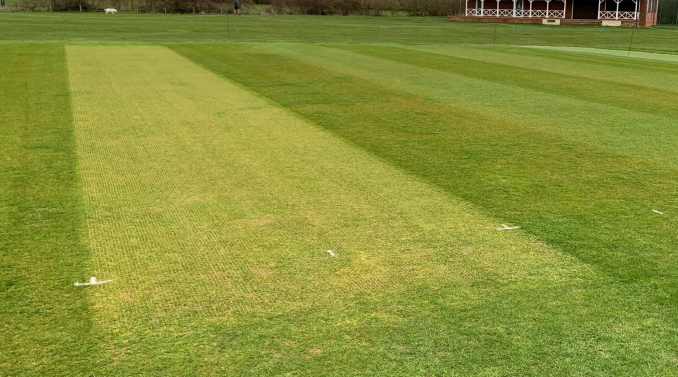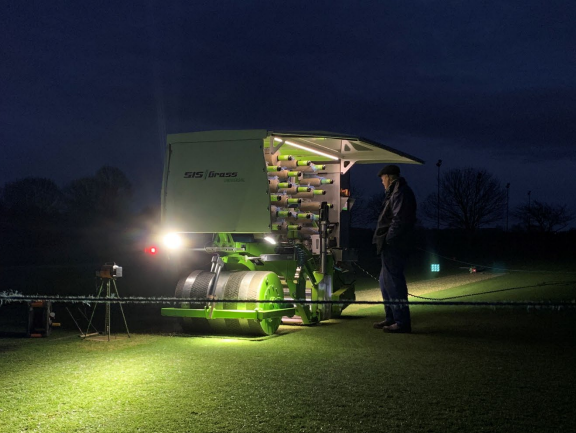What are hybrid pitches?
Hybrid pitches (sometimes referred to as ‘stitched pitches’) are fine-turf cricket pitches that have plastic fibres stitched into them in a regular pattern (normally a 20 mm x 20 mm grid) to 90 mm depth. The fibres, often beige or green in colour, remain proud of the surface to the same cut length as the grass on the pitch.
The fibres are installed using a specialist machine that needle-punches the fibres into the ground.
What are the benefits of hybrid pitches?
Hybrid pitches have been shown to have greater wear resistance than non-hybrid pitches of the same soil type. This has been quantified as a four times increase in wear resistance – but will depend on soil types, maintenance, and usage.
This increased wear resistance means that more games can be played on a hybrid pitch than a non-hybrid pitch, that there is less wear under ball impact and foot holes are shallower and need repairing less.
The fibres can help to retain the natural grass plants rather than them being removed completely from the profile by wear – this can mean pitches recover more quickly after use.
Hybrid pitches also maintain better and deeper drainage because the fibres act as conduits through the insertion holes for water infiltrating the soil profile. This can encourage better germination following pitch renovations.
Hybrid pitches can maintain more consistent pace and bounce because of the uniformity of ground cover and reduced wear – although this does mean that pitches do not deteriorate as quickly which can be an important positive factor in pitch performance in longer formats of the game as it is this deterioration which causes pitches to spin more over time.
Which pitches are suitable / unsuitable for hybrid installation?
Pitches that have a stone-free soil profile to a depth of at least 100 mm (4”) will be suitable but note that the stitching machine will follow the surface level – so if you have saddles or other surface level problems – these should be fixed before the pitch is stitched – you cannot change levels without burying fibre once stitching has taken place.
Likewise, if you have a thatch layer in your surface – this needs to be removed and levels redressed before any stitching takes place.
It is not possible to stitch into stony profiles because it damages the equipment.
Your pitch will need to be suitably moist to the 90 mm stitching depth to allow the needle to penetrate – so stitching normally takes place in one of two windows:
- Pre-season: Late February to early April
- Post-season: Late October to November
Outside of these windows the soil is either too dry and hard or the surface is too wet and will be damaged.
So, to recap, the following pitches should not be stitched until the problems are resolved:
- Pitches with surface level problems.
- Pitches with excessive thatch (> 5 mm)
- Pitches with stony profiles in the 0-90 mm depth
How does hybrid pitch maintenance differ from non-hybrid fine turf pitches?
In general, hybrid pitches can be maintained in the same way an non-hybrid pitches. All the processes that are used in the preparation of non-hybrid pitches are used on hybrid pitches (including vertically-acting scarifiers and verticutters), with the following exceptions:
- Control of cut height is very important – the plastic fibres do not regrow(!), so will have an above-surface fibre length equal to the lowest cut height they are subjected to. Be careful not to cut below the height set at installation (normally 5-6 mm, but it may be longer).
- Do not use horizontal planing rotors, such as those used to address saddles/levels on squares as this will remove above ground fibre. Only use vertically-acting scarifying rotors to manage the grass.
- Hybrid pitches require more water in routine maintenance and pitch preparation because of the greater infiltration rate. This is the flip-side of them being better draining.
- There is a period immediately following installation in which the pitches should not be used. This is to allow time for grass roots and soil structure to bind the fibres into the profile. Otherwise the fibres will lift out of the profile too easily and repairs will be required.
- Some fibre lift under bowlers feet can be expected – this should be trimmed with scissors and disposed of properly before being cut with mowers to avoid plastic contamination of grass clippings and the mower pulling the fibre up more. This becomes less after the first winter when the soil restructures.
- In high wear areas such as front foot landing areas or batters’ marks, the excessive wear can mean that limited areas of hand stitching are required after 2-3 seasons of use. The installer can provide a hand stitching kit for this purpose.
- There are two choices for foot-hole repairs:
- To bury the fibre in the repair and then remove the repair prior to renovation, standing the fibre back up. Do not leave the fibre buried under the repair.
- To work the foot-hole repair mix into the fibres, continually brushing up the fibres through the repair (this can help to stabilise the repair but takes longer than the first method.
End of Season Renovation of Hybrid Pitches
End of season renovation of hybrid pitches is as per the methods recommended for non-hybrid pitches
Make sure that any foot-hole repairs burying fibre are removed and the fibre brushed up before dressing to repair levels.
Late autumn-early winter can be a good period for hand-stitched repairs as it will be possible to get the tool into the ground. Be careful not to cause depressions in soft soil – use a board to kneel on if necessary.





 Tweet
Tweet